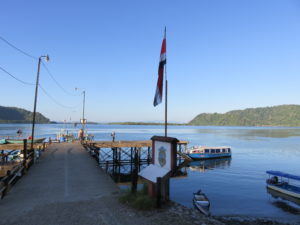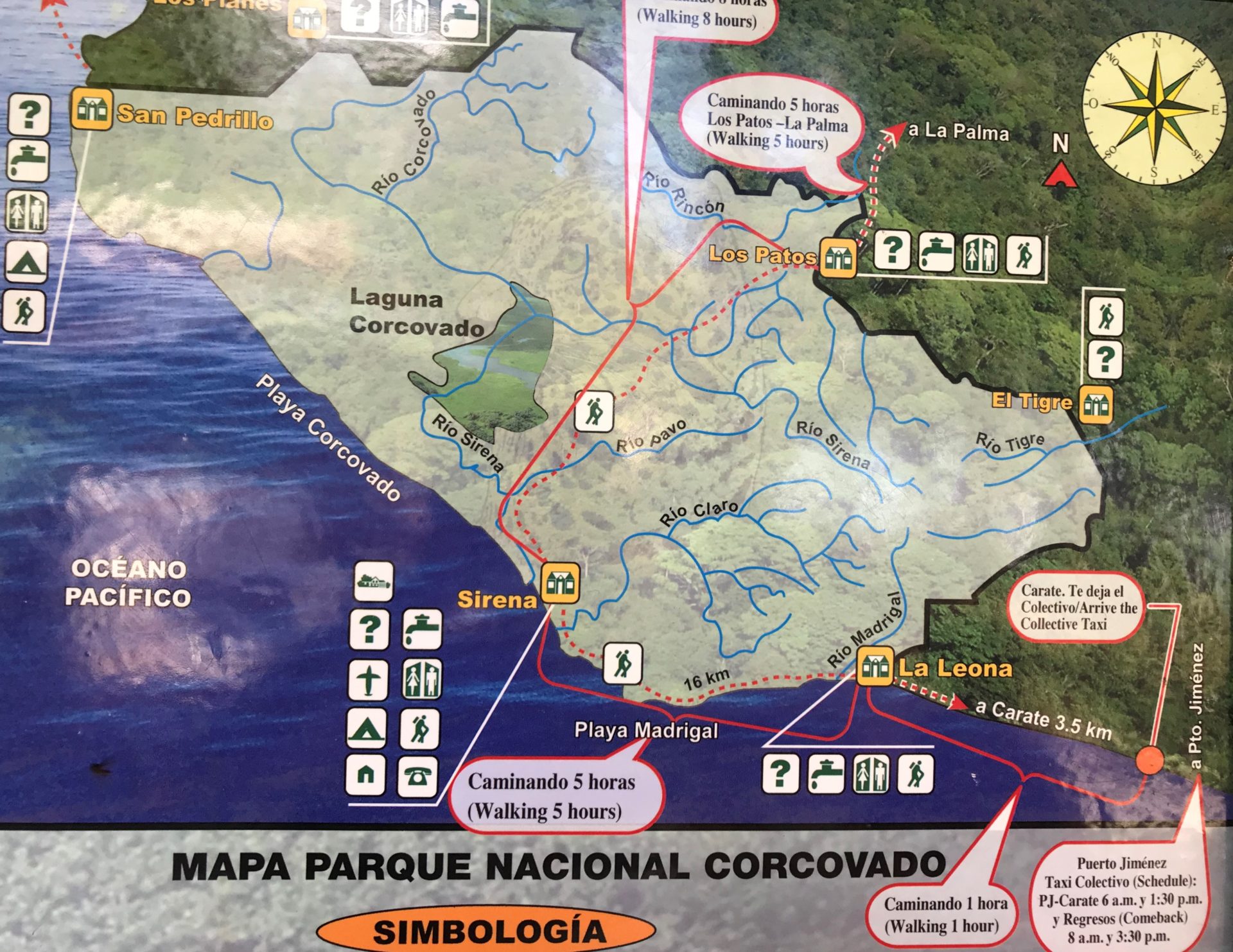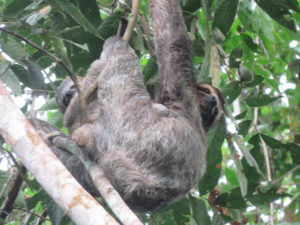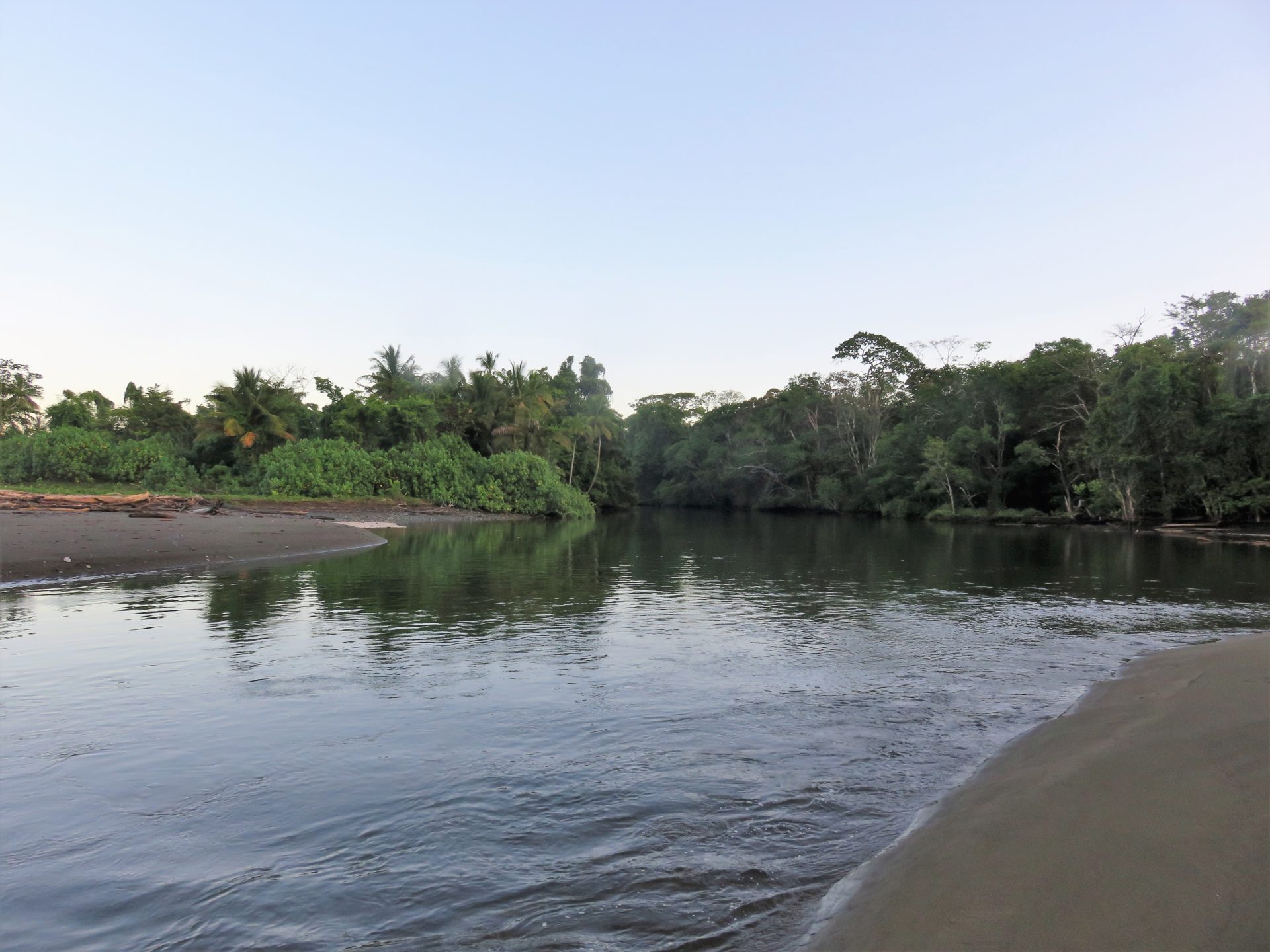On Thursday 30th January, I took the one o’clock shuttle bus from my home in Santa Catalina, Panama to Boquete to do something I have been looking forward to for years: hiking Corcovado National Park in Costa Rica! I asked the bus driver to drop me off along the highway in David. From there, I took a taxi to the busstop to get to the Panama – Costa Rican border at Paso Canoas. As always with these local micro buses there was no lack of people nor cheerful reggaeton-music.
After a few stops for people to get on and off, I arrived at the border-crossing for the Panama-exit and Costa Rica-entry stamps. There, I had to take yet another bus to Golfito to reach my hotel for the night. The hotel was called “Hotel Golfito”, a basic but pleasant hotel right next to the ferry terminal. The next morning I took the ferry at 7 a.m. accross the Golfo Dulce to Puerto Jimenez on the Osa Peninsula, a very nice half hour boat ride.

Monkeys on my roof, macaws in the trees and a croc in my garden
Arriving at Puerto Jimenez, I walked from the boat to my hostel for the night: La Chosa del Manglar Nature Retreat. A Nature retreat it was alright, I was welcomed by cappuchin monkeys upon arrival. They were jumping on the roof and swinging through the trees in the garden. They were everywhere!
The retreat was located in a mangrove right in town. Great setting! (except for the mosquitos;). After checking-in I went to my jungle bungalow that had a little porch and a river in front of it. One of the retreat’s staff members was in my garden viewing the river, looking for something. When I asked her what she was looking for, she said oh, just looking for the crocodile. What the..!%$?#! Lovely, Welcome to Puerto Jimenez, monkeys on the roof, macaws in the trees and a croc in my garden!
Preparing for hiking Corcovado National Park
The same afternoon I went to the Osa Wild tour agency that I already had contacted via email enquiring about a tour to Corcovado National Park. Here some short info on Corcovado National Park:
“Corcovado National Park contains 2,5% of the world’s biodiversity and its unique ecosystems house a staggering number of endangered, as well as endemic species: more than 800 species of trees, over 450 species of birds, 124 species of mammals and 117 species of reptiles and amphibians”.
Run by university-trained biologist Ifi and her husband Daniel, Osa Wild focuses on sustainability, environmental protection and the development of rural communities. There were two guided hikes I was interested in: the two-days or three days hike on the 20 km. coastal trail Carate – Sirena – Carate (see map below). Both have overnight stay in Sirena Ranger Station in the middle of the jungle.

Two or three day hike?
Since I preferred to travel with other individual travellers and thought I was fit enough to hike two days in a row, I decided on the two-day hike. Osa Wild provided me with a list of items to bring and an explanation of the route. The list of items I took with me, including a few things I added myself, was the following:
Jungle Checklist – What to bring when hiking Corcovado National Park
- 2 liters of water (+ Hadex water purifications drops)
- Flashlight
- Sunblock
- Insect repellent
- Hiking/sport shoes and sandals
- T-shirts and zip-off pants
- Swimwear
- Pocketknife
- Towel and personal care items
- Camera and binoculars
- Zip-loc waterproof bags
- Hat + sunglasses
- Snacks
- Poncho
Day 1 of my Corcovado hike
Getting up at 4.45h in the morning (!!!! arghh I hate early mornings!),I took a quick shower and prepared my kit for the hike. I walked through town to get to the meeting spot: the Monar bakery. There I was supposed to meet my guide Luis Angulo at 5.30 a.m. He was waiting for me there together with two other travellers that were in my group: Raffaella (“Raffa”) from Italy and Helen from China. We got into the jeep for a nice ride to Carate driving through the fields and forests and various rivers. And the wildlife already started during the ride. We stopped a few times on the way, once to see tucans and other birds and another time to see a collared anteater (northern tamandua), climbing up the tree. Puravida!
Beach hiking from Carate to Madrigal
The beginning of the trail in Carate was a beautiful sight. The sound of scarlet macaws passing overhead and sitting in the almond trees (they love almonds), the waves and beautiful beach. The first hour of walking was mostly beach passing several beautiful lodges until arriving at La Leona station, the entrance of the national park.
After registering at the station, we went in towards Madrigal with big red hibiscus flowers all around. Quite soon we saw spider monkeys in the trees above us and a family of coatis roaming the forest floor looking for food. Also we spotted another northern tamandua running up the tree like an acrobat.
Jungle and beach alternated eachother during the hike. Our lunch break we had at a freshwater stream coming out of the jungle, one of the many we came accross. Of course, this was also the perfect moment to have a bath and chill.
Running into a huge tapir
After hiking a few more hours we had a short break to rest and drink some water. I wandered of in the direction of the beach to see the ocean. Reaching the beach, I couldn’t believe my eyes: right in front of me there was a huge tapir on the sand eating leaves. It just stood there few meters in front of me, as if I was not there and continued munching away on his vegetarian delicacies. After taking a few shots with my camera, I went to get the others and tell them about my amazing discovery. They jumped up immediately to see it. So there we were, looking at the tapir from no further than 2 meters. After finishing his leaf, he decided to stretch out in front of us and take a nap. Unbelievable! After a few “tapir-selfies” we left him in peace and continued our way to the Rio Claro.
Crossing the Rio Claro – Crocs or no crocs?
Just before the river the was a wooden sign saying Rio Claro (river crossing). Wikipedia says the following on the Rio Claro:
“Small American crocodiles and spectacled caiman are also present within the Rio Claro, albeit in smaller numbers than Rio Sirena. Bull sharks are not believed to be present within the Rio Claro”.
So, is the glass half full or half empty? Ok, let’s do half full: lucky me, bull sharks are not “believed” to be present within the Rio Claro. Great! And only SMALL american crocodiles and caimen. Awesome! It seems to be my lucky day!
Since we arrived late at the river, the water level was high and the river wide and murky. It totally looked like a “croc river”. The girls couldn’t believe we had to cross it, but guide Luis Angulo quickly helped them out of their dream.
After making some jokes about the crocodiles that the ladies highly appreciated ;), I volunteered to go first. So, accompagnied by the words of our Italian reporter Raffaella, I walked in with my clothes and took my backpack in my hands above my head. The water was warm and as I walked away from the shore, it got deeper and deeper till in the end I even had to swim a bit. After finally making it to the other side, I heard Raffa with a suspiciously sweet voice saying “Remco, could you please come back to carry my backpack accross?”. I said: “Very funny” and “you are joking right?”. But no, she wasn’t….#$%^&^$#WTF?!!!!
Jungle chivalry
So as a true “jungle gentleman” I did what I had to do and went back through the river to carry her backpack accross and helping her cross at the same time. I guess its always good to have a tall Dutchman by your side in case of need (and convenience!, Italian ladies OMG!;)).
Sirena Ranger Station
Soon after the crossing and after spotting a “two-headed sloth” (see pic), a white-lipped peccary (a wild, rather ugly pig) and an armadillo, we arrived at Sirena Ranger Station. A wooden camp next to a wide grass airstrip in the middle of the rainforest. A beautiful sight after a long full-day walk. First thing we did after taking of our boots and signing in was to get some costa-rican beers, sit down and watch the beautiful surroundings from the wooden porch. ¡Pura vida!

Jungle WIFI & dinner
After our beers a ranger took us to our half-open dorm with bunkbeds covered by mosquito nets and told us which ones were ours, since there were many other hikers at the camp from all around the world. Italians, French, Spanish, Canadians, Americans, Japanese, Belgians, Swiss, in total I think about 40 people including the rangers that were staying there permanently. Nb. Unexpectedly they even had WIFI at Sirena that you can use (albeit slow).
At night we got a surprisingly good buffet meal with fish and rice in the dining area. Electricity was cut at 20.00h to save energy so only candles and flashlights after that and most people were going to bed early anyway. As was I, since I was pretty knackered from the hike. I climbed up my bed into my mosquito net, listened to the beautiful jungle sounds and quickly fell asleep.
Picture gallery day 1 Carate – Sirena
Day 2 of my Corcovado hike
We got up at around five when it was still dark for an early morning hike on the trails close to Sirena. As soon as I was down on the floor of my bed (takes a while this early…), I heard something in the forest. I turned on my flashlight and pointed it towards the jungle treeline accross the small grass field right from our dorm cabin. Immediately, I saw a huge tapir. An amazing sight and couldn’t believe it: yet another tapir and almost next to my bed!.
Early morning hike to Rio Sirena
We headed out with are flashlights down the grass airstrip and then right towards Rio Sirena. At Rio Sirena sometimes bullsharks could be seen depending on the tide and also crocodiles. Because of this Rio Sirena is not a river that can be crossed as the Rio Claro. Arriving at sunrise at the mouth of Rio Sirena into the ocean was a beautiful sight. I started scanning the surface and shores for sharks and crocs but unfortunately I didnt see any (although I later heard from others they did see crocs there in the morning). There were a couple of coatis around and also a lot of birds such as herons.
When we got back we had breakfast and then we headed out hiking back the same trail we came (an alternative is to hike back the los Patos trail which goes inland into primary forest, you see less wildlife but more forest). We were lucky enough to stumble upon the same tapir again on the way back (different location but close to where it was the day before). it was even more lazy now chillin on the beach sleeping.

Close encounter with a puma – distance less than 5 meters
During our lunch break we were joking with Luis that we now have to see a puma because we saw everything else already. Well, soon after, I guess our wishes were heard: A group that came from the opposite direction told us they saw a puma close to the trail somewhere near Madrigal in the direction we were heading. I couldn’t believe what I heard, a puma?. Wow!. I became very excited and wanted to get there as soon as we could to see if it was still there (ladies were less happy because of my increase in pace – I was hiking like Speedy Gonzalez on Steroids through the rainforest to find the kitten).
Then somewhere between Madrigal and la Leona, we saw a few people standing still on the trail looking at something in the bushes. And then I saw it: a beautiful puma sleeping in the bush. Unbelievable! We silently moved to the other side of the bush to get a better view and got up as close as 4 -5 meters distance. Extremely close. And although I was perfectly aware this was a wild animal I was very close to, I was not affraid at all. The feeling I had was that of fascination, excitement, feeling blessed and lucky to witness a beautiful animal I so much wanted to see once in my life and now it was actually happening. I started taking pictures of this beautiful cat (I even managed to take a selfie because it was so close). It appeared to have a dead monkey in between its claws, its favorite food: monkey kebab.
Frozen in eye contact with a puma
After observing the cat for a while, Helen moved away from the scene, accidentally stepping on some branches that snapped with a lot of noise. The puma immediately opened its eyes alerted looking straight in my eyes, with me being kneeled 5 meters in front of it. It was an exciting moment I will never forget. I was frozen and thinking: what will it do? I can tell you there was quite a bit of adrenaline going through my body. The approximately 10 seconds of direct eye contact felt like eternity and instead of running away or charging at me (the options I considered), it just closed its eyes again and continued its sleep.
Puma slideshow
Thrilled with excitement, we continued our way back to Carate where we celebrated our succesful adventure with cold beers that never tasted so good. We saw everything!.
I felt very happy and thank mother nature for revealing so many of her treasures to us those two days!
Return to Puerto Jimenez, trip to Drake and back home to Santa Catalina, Panama
Picked up by our 4 WD taxi, we went back to Puerto Jimenez where I spent one more night in la Chosa del Manglar Nature Retreat. The next day I went with Raffa to beautiful Drake on the other side of the peninsula for some chilling on the beach. In Drake I stayed at the lovely Drake Bay Paradise Lodge where I got invited by an Italian family to join their table for a BBQ dinner that eve. A great experience. The next day at 7.30 in the morning, I took a fast boat from Drake beach to Sierpe through the mangroves and after no less than 7 bus/micro/taxi transfers I arrived home at Coibahouse, Santa Catalina, Panama where I was welcomed by Darcy, happy puppy Coco and the rest of the family. What an amazing trip!





































Definitely earned its spot as top ten hikes in the world. Great blog Remco
Thanks Darcy!. You can attend your guests to it and recommend them to do the same trip. An unforgettable experience!
What a great story! A tapir and a puma in one hike, amazing.